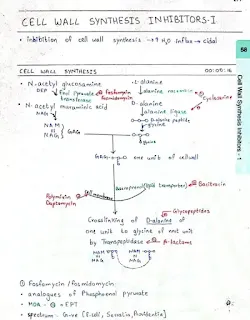Cell Wall Synthesis Inhibitor PDF Notes: Downloadable Resource
Download comprehensive notes on cell wall synthesis inhibitors in PDF format. These notes cover the different classes of antibiotics that target bacterial cell wall synthesis, including beta-lactams (penicillins, cephalosporins, carbapenems, monobactams), glycopeptides (vancomycin), and others (bacitracin, fosfomycin). Learn about their mechanisms of action, antibacterial spectrum, clinical uses, and potential side effects. Ideal for students, researchers, and healthcare professionals. Download now for convenient offline access.
Keywords: Cell Wall Synthesis Inhibitor, PDF, Download, Notes, Antibiotics, Beta-Lactams, Penicillins, Cephalosporins, Carbapenems, Monobactams, Glycopeptides, Vancomycin, Bacitracin, Fosfomycin, Mechanism of Action, Antibacterial, Pharmacology, Peptidoglycan, Transpeptidase, PBP, Bacterial Resistance.
Cell Wall Synthesis Inhibitors: Mechanisms and Classes
Cell wall synthesis inhibitors are a crucial class of antibiotics that target the unique structure of bacterial cell walls, which are essential for bacterial survival. Mammalian cells do not have cell walls, making these antibiotics relatively selective for bacteria and generally well-tolerated. This document provides an overview of cell wall synthesis inhibitors, their mechanisms of action, and major classes.
Bacterial Cell Wall Structure (Peptidoglycan)
The primary structural component of most bacterial cell walls is peptidoglycan. Peptidoglycan is a complex polymer consisting of:
- Glycan Chains: Long chains of alternating N-acetylglucosamine (NAG) and N-acetylmuramic acid (NAM) sugars.
- Peptide Cross-Links: Short peptide chains that connect the glycan chains, providing strength and rigidity to the cell wall. These peptides typically contain unusual D-amino acids (e.g., D-alanine).
The synthesis of peptidoglycan is a multi-step process that occurs in the cytoplasm, at the cytoplasmic membrane, and in the periplasmic space (in Gram-negative bacteria).
Mechanism of Action of Cell Wall Synthesis Inhibitors
Cell wall synthesis inhibitors generally target one of the steps in peptidoglycan synthesis. The most important class, the beta-lactams, target the final step: the cross-linking of the peptide chains.
- Transpeptidation: This is the final step in peptidoglycan synthesis. Enzymes called transpeptidases (also known as penicillin-binding proteins or PBPs) catalyze the formation of peptide cross-links between the glycan chains. These cross-links provide the cell wall with its strength and rigidity.
Classes of Cell Wall Synthesis Inhibitors
- Beta-Lactam Antibiotics: Contain a beta-lactam ring in their chemical structure. They inhibit bacterial cell wall synthesis by binding to and inactivating transpeptidases (PBPs). This prevents the formation of peptide cross-links, weakening the cell wall and leading to bacterial cell lysis (bursting). Beta-lactams are bactericidal (kill bacteria).
- Penicillins: (e.g., Penicillin G, Penicillin V, Amoxicillin, Ampicillin, Methicillin, Nafcillin, Piperacillin, Ticarcillin). Vary in their spectrum of activity, resistance to stomach acid, and susceptibility to beta-lactamases (enzymes produced by some bacteria that inactivate beta-lactam antibiotics).
- Cephalosporins: Classified into generations (1st, 2nd, 3rd, 4th, and 5th) based on their spectrum of activity. Generally more resistant to beta-lactamases than penicillins. Examples include Cephalexin, Cefuroxime, Ceftriaxone, Cefepime, and Ceftaroline.
- Carbapenems: (e.g., Imipenem, Meropenem, Ertapenem, Doripenem). Have a very broad spectrum of activity and are highly resistant to most beta-lactamases. Often used as "last-resort" antibiotics for serious infections.
- Monobactams: (e.g., Aztreonam). Active only against Gram-negative aerobic bacteria.
- Glycopeptide Antibiotics:
- Vancomycin: Binds to the D-Ala-D-Ala terminus of the peptide chains in peptidoglycan, preventing transpeptidation. *Does not bind to PBPs*. Effective primarily against Gram-positive bacteria. Used to treat serious infections, including those caused by methicillin-resistant Staphylococcus aureus (MRSA).
- Teicoplanin: Similar to vancomycin.
- Telavancin, Dalbavancin, Oritavancin: Lipoglycopeptides with additional mechanisms of action.
- Other Cell Wall Synthesis Inhibitors:
- Bacitracin: Inhibits the dephosphorylation of a lipid carrier molecule that transports peptidoglycan precursors across the cytoplasmic membrane. Used topically due to nephrotoxicity (kidney damage).
- Fosfomycin: Inhibits an early step in peptidoglycan synthesis (the formation of NAM). Used to treat uncomplicated urinary tract infections.
- Cycloserine: A structural analog of D-alanine; used as a second-line drug to treat tuberculosis.
Bacterial Resistance to Cell Wall Synthesis Inhibitors
Bacteria can develop resistance to cell wall synthesis inhibitors through several mechanisms:
- Beta-Lactamase Production: The most common mechanism of resistance to beta-lactam antibiotics. Beta-lactamases are enzymes that break down the beta-lactam ring, inactivating the antibiotic.
- Altered PBPs: Mutations in the genes encoding PBPs can lead to the production of PBPs with reduced affinity for beta-lactam antibiotics. This is the mechanism of methicillin resistance in MRSA.
- Decreased Permeability: Changes in the outer membrane of Gram-negative bacteria can reduce the penetration of antibiotics to their target sites.
- Efflux Pumps: Some bacteria have efflux pumps that actively pump antibiotics out of the cell.
Clinical use
- Cell wall synthesis inhibitors are used to treat a wide range of bacterial infections, including skin infections, respiratory tract infections, urinary tract infections, and bloodstream infections. The specific choice of antibiotic depends on the type of bacteria causing the infection and its susceptibility to different antibiotics.
Info!
If you are the copyright owner of this document and want to report it, please visit the copyright infringement notice page to submit a report.

